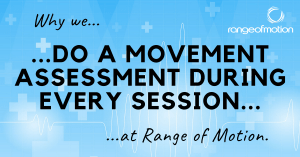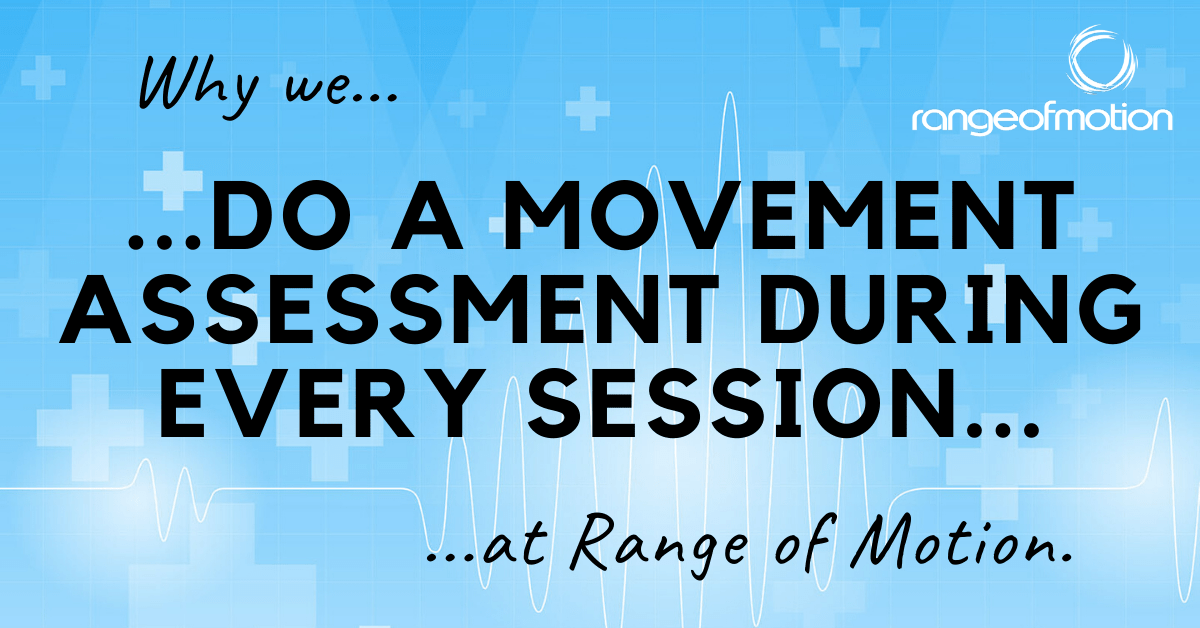Why we do a movement assessment during every session at Range of Motion.
 When you first come in to Range of Motion for a one-on-one exercise session with your Personal Coach, the first thing you’ll do (after saying ‘hi’ to all your friends!) is grab your ‘Range of Motion Session Flow Card’.
When you first come in to Range of Motion for a one-on-one exercise session with your Personal Coach, the first thing you’ll do (after saying ‘hi’ to all your friends!) is grab your ‘Range of Motion Session Flow Card’.
On this card, you’ll find a series of columns, with each column representing a different position or ‘shape’ your body can go in to. For example, there’s a column for a ‘squat’ position. There’s a column for holding a weight overhead. And one for hanging from a bar.
In total, there are 12 columns, for the 12 positions or ‘shapes’ your body can go into. And even though we do hundreds of different exercises at Range of Motion, they all come back to these 12 shapes.
We can learn a lot about your body from these shapes, and the quality of the positions your body is able to get in to.
For example, if you struggle to hold a weight over your head without your back arching, it can tell us a lot about your shoulders. If you back rounds when you’re picking something up off the floor (like a deadlift), it can tell us something about your back.
In fact, we use the positions in the exercises you do to diagnose issues with your musculo-sketal system (your muscles, bones and joints). Each of the 12 columns can teach us a lot about your body, with a total of 41 imbalances that we can assess you for each session.
And this is the real beauty of the exercises we do, not only are they the most effective way to get you healthier and fitter, they’re also the most effective way to diagnose any underlying problems with your muscles and joints.
As your Personal Coach (read: Why we focus on one-on-one Personal Coaching at Range of Motion) is guiding you through your individualised exercise session for the day (read: Why we have an individualised approach to exercise at Range of Motion), they will be circling on your card the main fault they see for each position in that day’s training. At the end of your session, you will have a complete movement assessment, a complete diagnosis, of any imbalances that impacted your quality of movement for that day.
Because if you have imbalances that are affecting how you move within Range of Motion, it’s a fair bet to say that those imbalances will be impacted your life outside Range of Motion (and that’s what really matters). And even if you’re not aware of them yet, they can lead to long term muscle soreness, joint pain, injury, poor posture or degeneration of your body (read: Why we prioritise movement quality at Range of Motion).
Of course, the diagnosis is only the first step of the process. Once you know your faults, we have a chart within Range of Motion which will tell you which remedial exercises to do to fix the imbalances causing the faults. Each fault your Personal Coach has circled has its own exercises to fix the imbalance. It might be a form of specialised stretching if the fault is caused by a muscle tightness (we’ll give you that info on your card too), or some form of extra stability or strengthening work if it’s caused by a muscle being underactive or too weak.
You’ll do the drills to help correct your body at the end of every exercise – a great healthy way to finish that day’s exercise.
Over time, you may notice your Personal Coach circles similar faults each time – that’s a sign that there is some stuff that really needs work. Every time they circle a fault on your card, you get the opportunity to do the drills to fix that fault. What this means, is that over time, you’ll devote the most time to fixing your biggest imbalances – and that’s how we make your body healthier!
So to answer the question…
We do a movement assessment during every session because we care about the health of your body, and believe there’s more to health than just fitness. We know that assessing your movement regularly, allows you to a get a ‘real time’ day-to-day update on your musculo-skeletal system, and daily opportunities to improve your body’s health.





